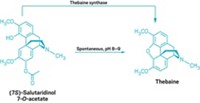Advertisement
Grab your lab coat. Let's get started
Welcome!
Welcome!
Create an account below to get 6 C&EN articles per month, receive newsletters and more - all free.
It seems this is your first time logging in online. Please enter the following information to continue.
As an ACS member you automatically get access to this site. All we need is few more details to create your reading experience.
Not you? Sign in with a different account.
Not you? Sign in with a different account.
ERROR 1
ERROR 1
ERROR 2
ERROR 2
ERROR 2
ERROR 2
ERROR 2
Password and Confirm password must match.
If you have an ACS member number, please enter it here so we can link this account to your membership. (optional)
ERROR 2
ACS values your privacy. By submitting your information, you are gaining access to C&EN and subscribing to our weekly newsletter. We use the information you provide to make your reading experience better, and we will never sell your data to third party members.
Biological Chemistry
Maximizing Codeine
Plant Biochemistry: Researchers identify enzymes that convert codeine to morphine in poppy plants
by Sarah Everts
March 17, 2010
| A version of this story appeared in
Volume 88, Issue 12

The poppy plant's recipe for building morphine generates other pharmaceutically useful painkillers such as codeine and thebaine along the way, but some of the important biosynthetic enzymes involved in the plant's opioid production have long eluded researchers.
Now, plant biochemists Jillian Hagel and Peter Facchini of the University of Calgary, in Alberta, are reporting genes for two previously unknown enzymes involved in morphine biosynthesis, including an enzyme called CODM that performs the final O-demethylation step that converts codeine into morphine (Nat. Chem. Biol., DOI: 10.1038/nchembio.317).
The discovery of these genes could lead to new pharmaceutical codeine production methods, such as by microbial fermentation. Production of codeine currently relies on extraction of opioids from poppy plants (Papaver somniferum), followed by chemical modification of the noncodeine opioids.
This work "is very important scientifically," comments Philip Larkin, a plant biochemist at Commonwealth Scientific & Industrial Research Organisation, Australia's national science agency. "These genes have long been sought."
The enzyme responsible for converting codeine to morphine in poppy plants was thought to be a cytochrome P450 enzyme, but the culprit for the O-demethylation step turns out to be a dioxygenase—CODM—instead, Facchini says.
When Hagel and Facchini, using a virus, reduced poppy expression of the CODM gene, they increased codeine levels in plants from about 20% to about 65% of the total alkaloid content. At the same time, morphine levels decreased from about 70% to about 15% of the total, Facchini notes.
The easiest way to commercialize the results would be to engineer out the CODM gene from opium plants so they are able to produce codeine but not morphine. However, strong opposition to genetically modifying plants, particularly in Tasmania and France, both suppliers of pharmaceutical opioids, stymies this avenue of commercialization, Facchini notes. Furthermore, the Tasmanian poppy industry is already raising codeine content in plants with some success "through mutations achieved independently from genetic engineering," Larkin adds.
Instead, Facchini and Hagel suggest getting bacteria or yeast to produce codeine by engineering biosynthetic genes into the microbes as perhaps a cheaper and less controversial alternative. Insulin is currently made this way, with little objection from the general public about the genetically engineered product. Furthermore, because opioids are controlled substances, microbial fermentation might be easier to regulate and monitor than production in plants.





Join the conversation
Contact the reporter
Submit a Letter to the Editor for publication
Engage with us on Twitter